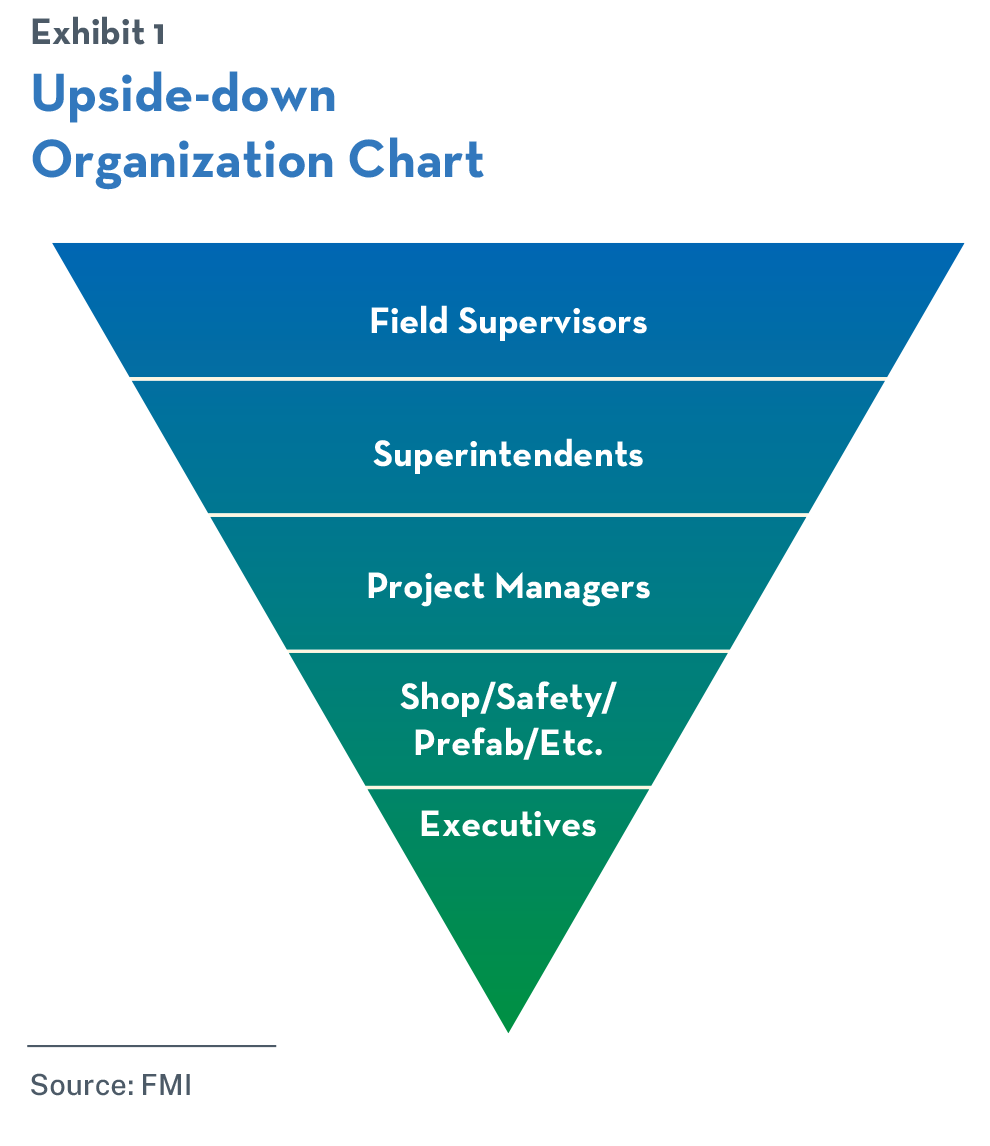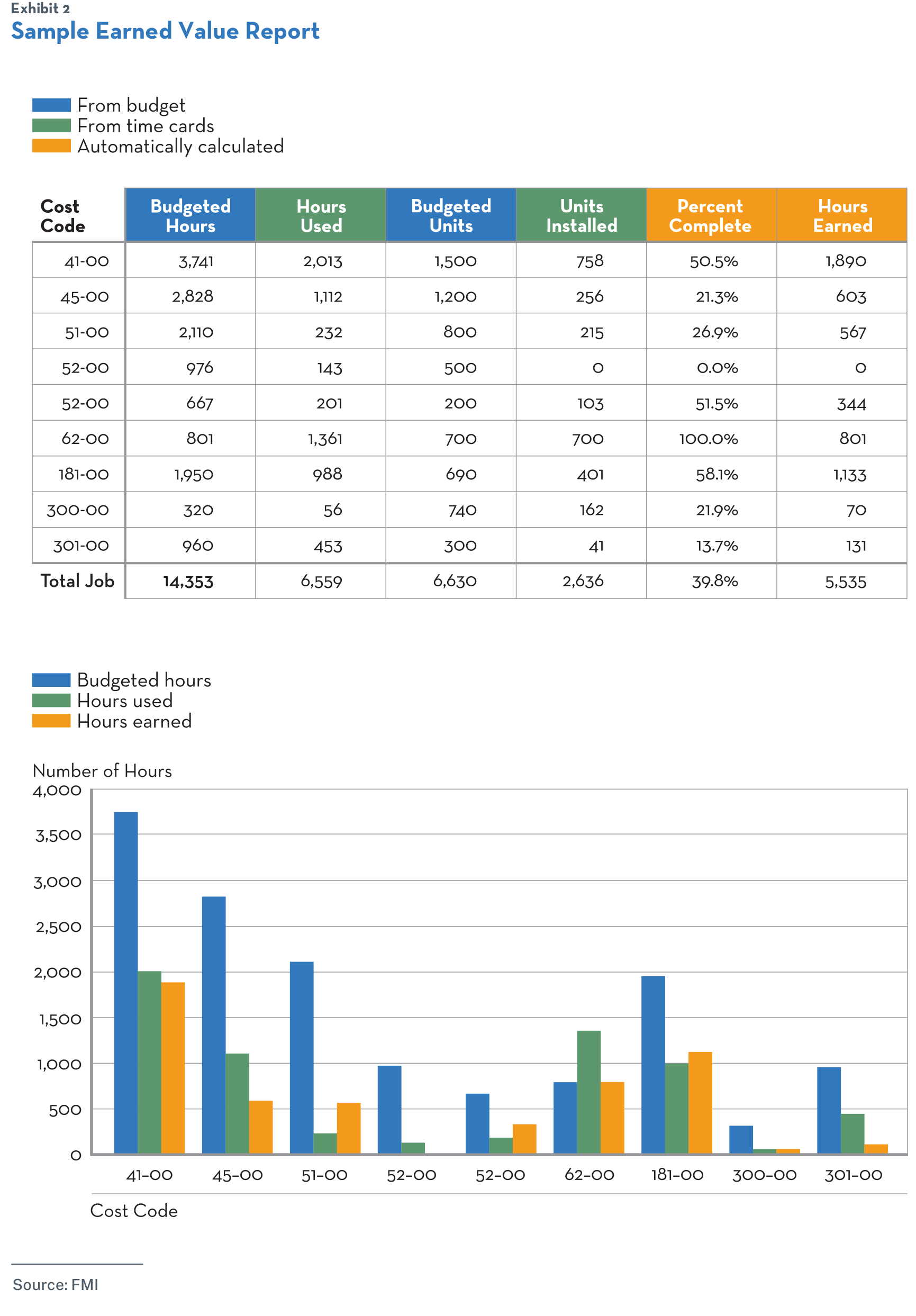Trading on Excellence: The Value of Talented Field Leaders
.png)
When engineering and construction (E&C) firms think about leadership development, the focus naturally goes to C-suite and business development teams.
While those managers are a critical part of a firm’s ultimate success, companies often neglect to develop on-site leaders who are ensuring projects are completed to exacting standards, on time and on budget.
World-class construction firms understand the value of focusing on those working in the field and of inverting their organizational pyramid so that field supervisors, superintendents and project managers are prioritized instead of executives (Exhibit 1). This puts the organizational emphasis on individuals who are out in the field every day planning projects, setting goals, ensuring safety protocols are followed, training up-and-comers, boosting morale, managing risk and demonstrating best practices. The livelihood of their companies depends on these individuals’ day-to-day work.

Finding and Keeping Good Field Leaders
There are two major challenges to finding and keeping good field leaders. The first is the construction talent shortage. Labor shortages were the second most common cause cited for project delays in the 2022 AGC/FMI Surety Bonding and Construction Risk Management Study, and in-house staffing capabilities were identified as a major determinant for project go/no-go decisions.
Field supervisors, project managers and superintendents represent an outsized slice of the struggle to attract and retain talented people. Of the CEOs surveyed for the second quarter 2022 Construction Industry Round Table (CIRT), nearly two-thirds (63%) reported difficulties finding field managers. Twenty-nine percent said they were experiencing high turnover in their management field staffs.
The second challenge among field leaders is the trend toward being asked to do too much too soon. FMI Project Manager Academy data indicates that overwork and a lack of skills training and career support are huge issues in construction. Research shows that stress and burnout are more pervasive among less experienced construction workers and that professional development is the antidote.
Most firms recognize the importance of talent development, but many of them overlook the need for field staff to hone their business skills. Almost all CIRT members teach leadership and managerial skills, but only a third put a focus on business acumen. Field supervisors are in a position of leadership and need experience and training to plan projects, prevent rework and keep crews productive.
Both formalized skills training and systemic processes that foster learnings have an outsized impact on project performance. Here we identify key opportunities to help field leaders take operations to the next level.
Pre-Planning Involvement
Often, field supervisors only come into the office when they are between projects. When the backlog is full, they are out on the job site. This is a missed opportunity because when field leaders are involved in project planning, they become project managers and can assess the logistics of mobilization and document what they need based on the scope of work.
Once they have been brought into the loop with the general contractor, field supervisors can visit the job site and consider their manpower, tools, equipment, materials and additional information needs. Those needs can then be procured by project managers, superintendents and purchasing teams.
On early visits to the job site, field supervisors should consider:
- Access to site for delivery trucks and machinery.
- Traffic patterns, school zones, foot traffic and neighborhood particulars.
- Utility locations, locates and overhead restrictions.
- Locations for parking and portable toilets.
- Location and size of laydown yards.
- Status of project: Is it/will it be ready to mobilize, etc.?
Following the site visit, a field leader should:
- Create a list of tools and equipment needed.
- Set out the first set of goals and short-interval plans. What do we need to be productive for day one, hour one?
- Provide input/confirmation on budget and schedule.
- List any questions or concerns to be answered prior to mobilization.
FMI’s research shows that early involvement by field supervisors lifts productivity, profitability and overall project success. Field leaders with budget management, performance tracking, mentoring, time management and other project management training can do a better job of lifting overall performance.
Case Study
A mechanical contractor was feverishly putting together its final numbers for a bid. Minutes before the deadline, it successfully submitted the numbers. Soon the company was notified that it had won the job, with a lot of money left on the table. Instantly, the company began to suspect it missed something. As it reviewed the data, the contractor found a row of numbers were left out of the spreadsheet’s formula sum. About 15% of the project’s labor, equipment and material was not included in the final numbers.
The company decided to go forward with the project anyway. Knowing what it had missed, the company added back the needed budget dollars and hours before it handed the project over to the field. “Look, we had an estimating bust on this project. We added the needed dollars and hours into the budget once we found the mistake. We want to hold you accountable for a realistic budget. We know that we will be losing money on this project if we cannot make up for the bust with increased productivity.”
Results
The field staff knew the labor budget given to them was accurate and that they had an opportunity to help the company perform in a tough situation. With the support, hard work and some great ideas from the field, the project ended up almost breaking even. Compared with the original budgeted loss, this was seen as a huge victory.
The field knew where they were being held accountable and where the office would be held accountable. Overall, morale and trust were built up rather than destroyed through the experience.
Skills Training and Mentorship
Previous generations of field leaders learned through on-site experience and may not have formal training. That means that the knowledge passed on to up-and-coming leaders is limited. Now, with a shortage of experienced field leaders, people are being asked to lead or make decisions without the experience or supervision they may have had in the past. As we know, training helps with talent retention as well as the bottom line of a project. So what can be done?
Start by assessing your employees’ skills and competencies. Define the minimum requirements for roles and what is needed to meet or exceed those expectations. Next, make sure you can measure these skills, and if someone is found lacking, offer resources to support them.
Creating a learning lab for younger project managers exposes them to complex projects and operations. This builds confidence and can reduce the risk of burnout. Formal mentoring arrangements enable knowledge transfer and—as they gain proficiency and experience—ultimately a llow more staff members to take ownership of projects. Mentoring can also serve as a crucial part of succession planning at different levels.
However, the lack of formal training programs in the past means that senior leaders may not be skilled at teaching inexperienced workers. This can be addressed with leadership training for those with valuable job knowledge and ongoing skills training as people progress in the field.
Project Tracking
Project performance is measured by daily job achievements and whether teams are keeping up with the schedule and budget or not. If field leaders don’t know where a project stands or how it’s performing, then no one else will either. Crews and their supervisors need to see on a weekly basis how they’re measuring compared to the budget.
Goal setting is a tool that can provide accountability for crews and help field leaders develop instincts about how best to maximize performance. Leaders should consider the daily job site conditions, their staffing, individuals’ skills, where the material is located, whether the area is ready for them, and what scopes of work will be executed. Using that information, they can develop a written production goal for that day. This creates buy-in from the team.
At the end of the day, taking time to ask questions about what went well and what needs improvement hones the team’s understanding of the job and helps even inexperienced tradespeople to think strategically. Then, on a weekly basis, teams need to know how they are performing against the budget. This is where formal project tracking can be a powerful tool for foremen.
The simplest and most effective way to track performance is with an earned value graph (Exhibit 2) containing cost codes, budgeted hours, budgeted number of units, and then actual hours and units installed. This will provide a clear and comprehensive
picture of risk and progress against the budget. Color-coded graphs can make this information especially vivid.
A few other rules to follow include:
- Keep it visual. Graphical information is easier and faster to process and understand than written reports.
- Make it timely. Be sure to update information and numbers regularly.
- Be concise. Anyone looking at the information should be able to understand what it is saying in 15 seconds or less.
- Think simplicity. Make sure the key information is at the forefront and save projections, averages and trends for after the job is completed.

Invest in Field Leaders or Risk Losing Them
Field leaders, supervisors and project managers understand projects better than anyone else. The view from the corporate box simply doesn’t capture the complexity of what’s happening on the ground. No matter how finely tuned the communication channels, no one knows where a project stands unless someone out in the field is tracking its performance.
Field leaders touch almost all aspects of a job and shoulder a significant share of project risk. They are at risk of burnout, being poached and/or leaving the industry. Investing in their skills isn’t just a project imperative; it can help you win the game.
Companies that invest in field supervisors can lower business risk by building a deep pipeline of strong talent, enhance their ability to execute on project, increase employee engagement and organizational loyalty, and improve field leaders’ ability to take on greater responsibility. Only then can individuals reach their peak potential as leaders, understand their leadership effectiveness through feedback and coaching, and learn how to improve their leadership performance.



